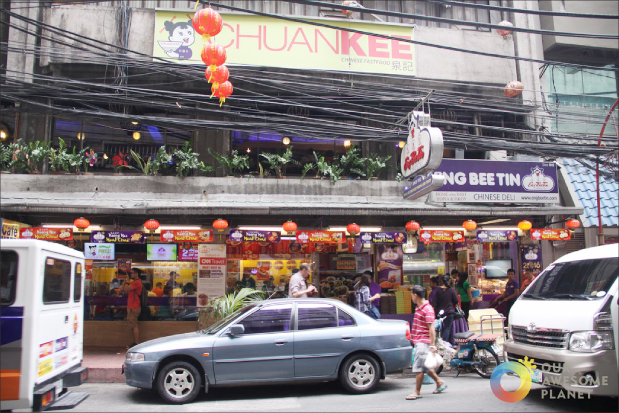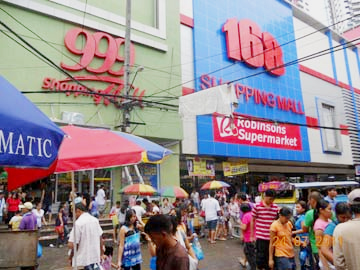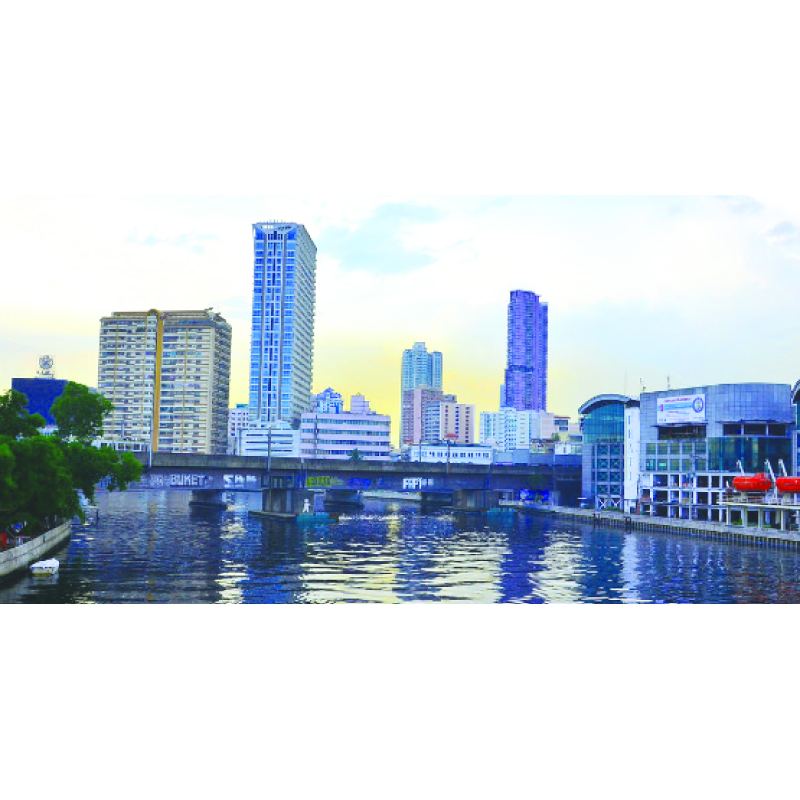
In a talk before the Chinese Filipino Business Club, I asked the audience if anyone remembered the original name of San Fernando Bridge. Only a few raised their hands and said “Baybay Kio” or Baybay Bridge. Young people and newcomers are no longer familiar with the essence of Binondo that made it unique in the world – a place where different people from different walks and ways of life co-mingle, co-exist, and cooperate, finding the middle ground to build new beliefs, new traditions. And new lives.
Binondo in my memories
Those who grew up in Binondo remember Caballeros as tsut-si-ah hang, literally meaning hybrid alley, Jaboneros as sab-un kwei (soap street), Carvajal as ho-suah-hang (umbrella alley), Rosario as chiu-ah-huah (coastal river bank) and Nueva as aw-kueh-ah (back street).
The names exactly reflect what the streets are for: selling and trading particular products (soap and umbrellas), a back street of the main thoroughfare, Rosario, a street where most mestizos live.
I was 5 years old when we moved from Malabon to Binondo. We changed residences many times, but they were all within a small area bound by Sto. Cristo and Madrid streets.
The longest period was in a typical looban in San Nicolas, it was how houses for rent were aligned before the concept of compounds and condominiums. The looban has a row of five to 10 houses, with a long alley in front where children can play or oldies can bring out their rocking chairs and chat or play checkers.
We know one another, empathize and help one another out. During festivities, the better off neighbors (no one was rich in the neighborhood) occasionally shared food.
I hated Binondo then, and I still don’t like it now because of some childhood memories. I remember the big fires that hit Binondo in the late 1950s to early 1960s. My mother had packed several sacks of clothes and documents and memorabilia and brought them to my uncle’s house in Alabang so we won’t be left with nothing if the worst happens and our house, with our little possessions, go up in fire.
Just when we felt safer and my mom brought back our things from Alabang, the worst did happen.
On Jan. 15, 1965, during the Tondo fiesta, when neighbors were not around, our landlord set fire to his warehouse below the apartment where we lived. Since the fire happened from below, my mother and I had time only to get some things from our closet and bring my three young sisters (ages 4, 5 and 6) who were at home, downstairs and out.
We lost everything, including priceless photographs and our many school certificates awarding us recognition. The most priceless was a grade four certificate from Anglo Chinese School stating that I topped the nationwide achievement test in English, besting schools like Ateneo de Manila, University of the Philippines and other elite schools.
It was no consolation that the landlord was arrested and deported. It was doubly painful because I was tutoring four of his children, often finishing very late at night because they were very slow learners.
Times were really difficult then because we had lost our father four years earlier and the older children were working to support the family as well as our own schooling. Such childhood experiences tainted my memories of Binondo. They didn’t give us any consideration at all when they decided to burn down the house.
Today, my experience of Binondo has not improved. It is a crowded, congested place with slow moving traffic, and where commercialism reigns supreme.

Where is old Binondo?
I recently had a lengthy chat with some old timers who are members of Kaisa Para Sa Kaunlaran. It revealed the many changes that have happened to the Binondo of my childhood.
Binondo’s Chinatown is less a creation by edict and more by metamorphosis. It became what it is because of the lives lived, culture negotiated and transformed and traditions preserved or discarded. In it is a community in flux, constantly adjusting, changing, transforming. The outcome is one that is uniquely the Philippines’ own.
It has seen an exodus as residents moved to the suburbs, then returned. It has grown to take in new migrants from China, seeking to make a better living than opportunities allowed in the old country.
Old timers recognize that integration has happened among younger Tsinoy generations locally born, bred and educated. Filipino is often the language they are comfortable with and what they use most at home. They identify with Filipinos.
The Chinatown they reside in has been a permeable environment influenced by the majority in mainstream society. In contrast, the early immigrants, who were born in China and transported to an alien, often inhospitable climate, had to band together to savor familiar things they were comfortable with.
Changes to Binondo Chinatown’s character happened slowly. From the late 1980s to early 2000 especially, Chinatown gave way to a Tsinoytown, a showcase of the unique blending of the Tsino and the Pinoy.
But the last two decades brought changes that seem to bring back the Chinatown of yore…but yet not quite the same. This “old Chinatown” rebirth no longer caters to the old timers in Binondo, but to the new faces and lifestyles of immigrants from China.

A blending of two cultures
Hankering for food and taste of old, of course, was the most talked about topic in our conversations. The old timers reminisced and named one by one the panciterias of yore – Hong Lay Kee (蓬萊居), Tony’s Kitchenette (萬香咖啡), Sin Jin Yak (新晉益), Tan Kiaw (陳窕), Panciteria Moderna (芳園).
Apparently, only Chuan Kee (泉記) on Ongpin cor. Nueva, Chui Guat Lao (Ilang-Ilang Restaurant 醉月樓) and Lo Wan (魯園 Shantung Restaurant that moved to Quezon City) still thrive.
They long for these panciterias of old that served authentic southern style sate noodles, humba, hot and sour soup, lomi, lobihon, chami, just like how they were done in their home villages.
Initially, when Chinatown transformed to become Tsinoytown, the more popular panciterias, Tiong Kok Panciteria (中國酒家) and Tsui Hua Tnia (翠華廳 International House) gave way to fastfood chains like McDonald’s and Jollibee. The siopao and siomai of old were replaced by burgers, chiffon and refrigerator cakes. Instead of mami and bihon, we had palabok and spaghetti. The familiar E-meng (Xiamen) lumpia became indigenized and filipinized into lumpiang shanghai, lumpiang ubod, lumpiang toge.
The old favorite staple Chinese hopia (好餅) became indigenized and transformed, using not just the familiar mongo (mung beans) but other native ingredients like ube (purple yam), kundol (winter melon) and piña (pineapple) and other native combinations.
By late 1990s, Chinese movie houses and bookstores were gone. Instead of recordings of Chinese songs and shows, the sidewalk vendors offer CDs of Beatles, Elvis Presley, Paul Anka and pirated Hollywood movie flicks. The sing-song cadence of Chinese music gave way to OPM (original Pilipino music) with Freddie Aguilar’s “Anak” being a favorite tune.
By legislative fiat of the late Manila Mayor Antonio Villegas in 1970, which banned the presence of Chinese signs from all business establishments, including those in Binondo’s Chinatown, the pretty, colorful characters, some rendered in unique calligraphy carved on old hard wood, disappeared.
When the ban was lifted by the next mayor, Ramon Bagatsing (1973-1981), most of the businesses opted not to put up their Chinese signs again, and the China flavor of Chinatown waned further.

New skyline, new facades
But the last two decades saw another metamorphosis that may yet become the permanent face of Binondo. The changes in residents, structures and lifestyles were accompanied by changes in the look, smells and tastes of the Chinatown.
The influx of immigrants saw high rise condominiums rise 40 storeys and higher, transforming Binondo’s skyline, dominated by thin, tall buildings.
The accessorias of old – wooden buildings with the ground floor used as storefront or warehouse – are nearly all gone. They have been replaced by cement and steel structures that seem to reach the sky.
In the mid-1990s, new buildings were 20 to 25 storeys high, but in the mid-2000s, buildings 30 to 40 storeys high became the norm. Immigrants from China and Hong Kong are used to small spaces, so they do not find 40 to 50 square meters too limited a space. The units are quickly gobbled up and paid for in cash.
Because of the horrendous traffic and deteriorating peace and order – the threat of kidnapping topping the list – many Tsinoy families who moved out to the suburbs began moving back to Binondo-Chinatown area.
Their businesses are still in Binondo and they find travel between their suburban homes and downtown offices inconvenient and time-consuming. Their factories may have moved to the suburbs but Binondo-Divisoria remains their distribution hubs.
With few old properties in the area left, the prices of available real estate in Binondo-Chinatown have risen even higher than properties in the elite hub of Makati. These new buildings have residential units in the upper floors and offices and commercial establishments in the lower floors.
Chinatown is back, but not quite
The influx of the new immigrants, numbering about 100,000, have again changed the face of Binondo, not just physically, but culturally and socially as well. Immigrants have brought back the old “Chinatown” ambience, with new Chinese restaurants (ranging from Southern to Northern cuisine), bookstores, music and curio shops, Chinese specialty stores and drugstores sprouting up to cater to them.
In a nod to culinary diversity, McDonald’s and Jollibee are present and joined by Starbucks, Seattle’s Best, Coffee Bean & Tea Leaf, and Dunkin’ Donuts.
The presence of new immigrants saw the rise of Tutuban Mall and Divisoria Mall, joined a bit later by the famous 168 mall (168 sounds like the Chinese words for “all the way to prosperity”), selling dry goods at rock bottom prices. It is frequented even by former first lady Imelda Marcos. A wedding entourage of 10 people can have a wedding gown and formal attire made for less than P20,000. Filipiniana gowns can be bought 50 percent cheaper.
The 168 Mall was soon joined by malls named 999 and 11/88. Carpenters, electricians, and other workers enthuse at the availability of affordably priced tools they need for their trade at these malls.The shops are dark, crowded and uncomfortable but who cares if prices are cheap. My daughter bought really warm winter wear there.
A new addition is the upper scale Lucky Chinatown Mall: air conditioned, well lighted and spacious, bringing the ambiance of suburban malls to the inner city.

Likewise, there are now small shops that sell only Chinese products. New small shops, supermarkets and specialty stores sell Chinese food and delicacies used in everyday life: dried preserved fruits, herbs, Chinese-style instant noodles, tea and the like are displacing Bee Tin, Diao Eng Chay and an older supermarket.
My friends in Quezon City ask my help to buy lotus leaves (for wrapping chicken), red dates and black and white fungus (believed to declog arteries for blood circulation), lingzhi pills (reishi mushroom said to boost immunity) si-but (four herbs for recuperating soup) and such products. These are now easily available.
Mandarin (official language of the north), instead of Hokkien (southern dialect, lingua franca of the Tsinoy community) now rules the cacophony of sounds. Dialects from other provinces, hitherto never heard being spoken, are now heard in many of the shops.
“With the phenomenal growth of China, why did you choose to come to the Philippines?” I ask small shop owners.
They said that opportunities still abound for small shopkeepers like them, especially with the big Philippine population.
“It’s easy to make money here and Filipinos are very kind and tolerant,” they added. This easy acceptance of fellowmen is reason enough for them to stay and brave challenges that newcomers face.

A pluralistic hub of cultures
While Chinese heritage and culture is more dominant and visible around Binondo, the Chinatown in the Philippines is nevertheless unique. It is a crossroad where Filipino, Spanish, American and Chinese cultures met, mixed, blended, adapted and transformed.
It is not an isolated incident to hear young people (children of new immigrants) switch from Tagalog to Hokkien to English and now to Mandarin. Chinese newbies find the conversation strange but learn fast to appreciate the pluralism that colors Philippine society.
Through historical to modern times, Chinatown has shown a plural mix of a multi-faceted, multi-functional, multi-dimensional existence in different periods…with different generations. It is a visible and tangible testament to the rich and complex history of the Philippines, where different cultures and origins are constantly adjusting, adapting, changing and where traditions intersect, intertwine and interact and transform into something uniquely the Philippines’ own.
